Spring MVC的參數綁定和返回值問題
參數綁定過程
在springMVC中,從前端(頁面:jsp…)發送請求到后端(controller…),會包含一些數據,數據是如何到達Controller,這個過程就是參數綁定過程
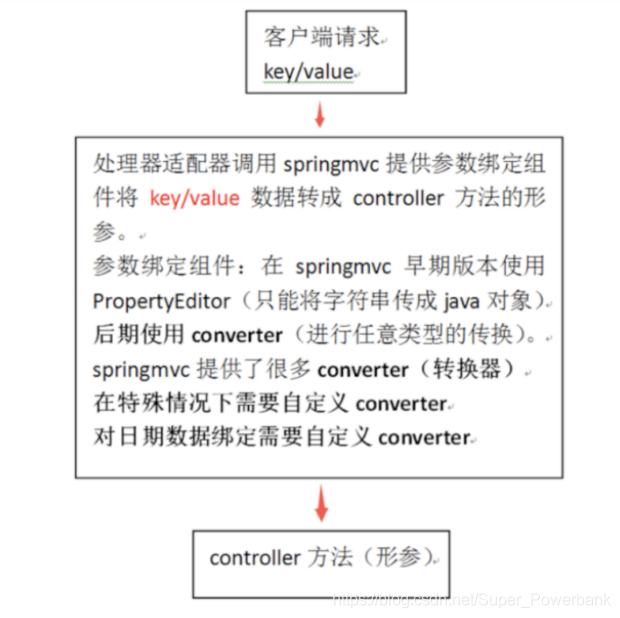
1、默認支持的類型
SpringMVC有支持的默認的參數類型,在方法上給出默認的參數類型的聲明就可以直接使用
HttpServletRequest request:通過request對象來獲取請求的信息 HttpServletResponse response:通過response來處理響應信息 HttpSession session:通過session對象來存放緩存信息 Model model:Model是一個接口,modelMap是一個接口實現,將model信息填充到request中public String index(HttpServletRequest request, HttpServletResponse response, HttpSession session, Model model) { //返回的modelAndView //指定返回的頁面
2、基本數據類型
基本的數據類型也支持綁定,基礎的數據類型包括byte、short、int、long 、float、double、char、boolean
JSP頁面:
<html><head> <title>測試基本數據類型</title></head><body><!-- 測試基本的數據類型綁定:form表單向后端提交數據 --><form action='/index/basedataType' method='post'> <input type='text' name='username'> <input type='submit' value='提交'></form></body></html>
controller層:
@RequestMapping('/basedataType')public void baseDataType(int username) { System.out.println('基本數據類型:'+username);} 注意:表單上Input中的name值和controller的參數的變量名保持一致,則能完成數據綁定,如果不一致呢? 需要@RequestParam注解來完成,JSP頁面不用改變

使用@RequestParam注解就可以解決頁面Input的name值和controller方法形參名不一致的問題
注意:基本的數據類型和包裝類型(Integer,Long…)以及String類型參數綁定都是適用于以上基本類型參數綁定,基本類型和包裝類型的區別:基本類型傳遞參數不能為null或者“”,否則會出現數據轉化的異常,包裝類型不會出現這種問題,建議使用時使用包裝。
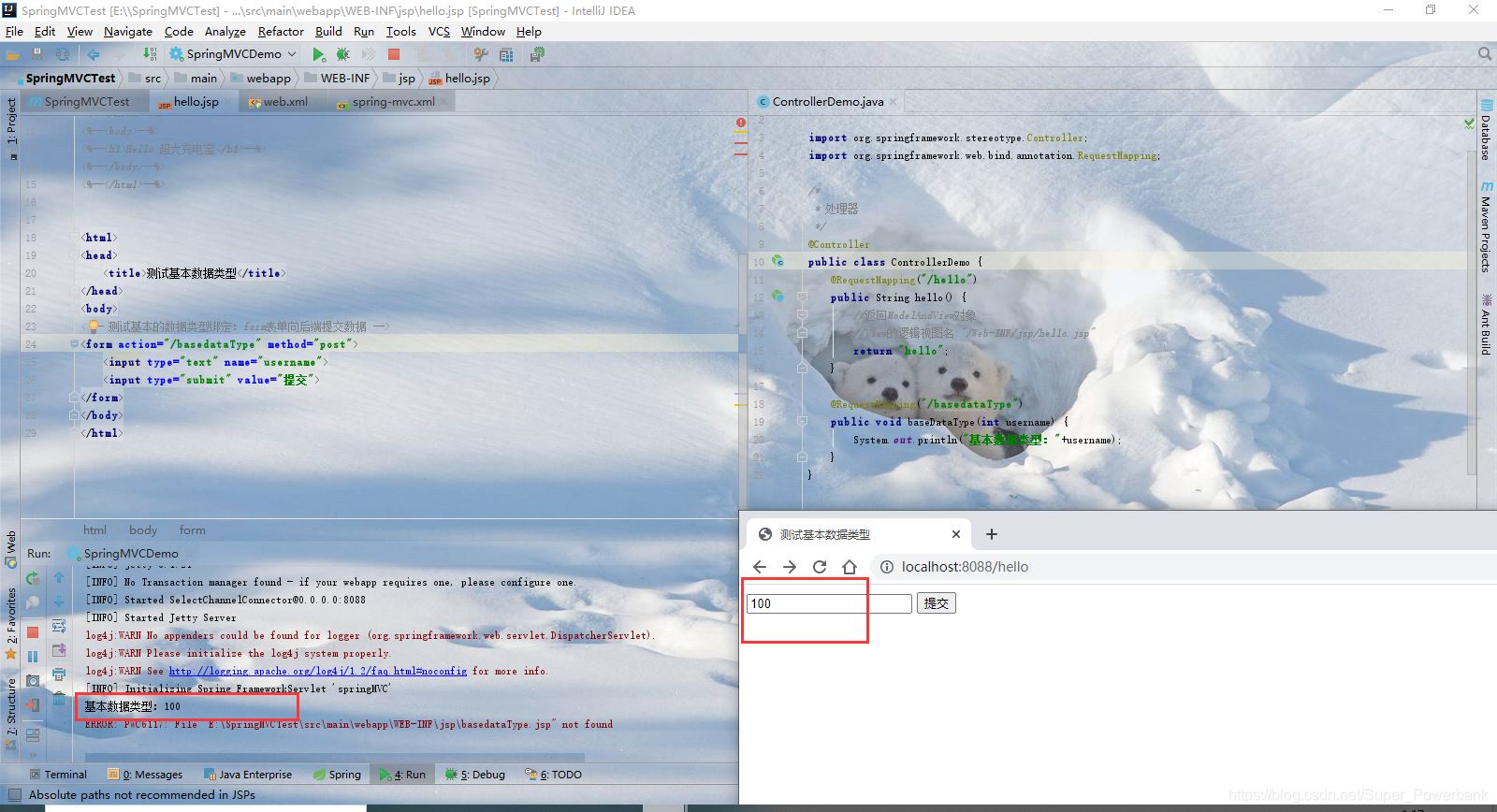
3、自定義類型
自定義類型的類(User)
public class User { private Long id; private String name; private String address;}//getter setter toString
JSP頁面
<%@ page language='java' contentType='text/html; charset=UTF-8' pageEncoding='UTF-8' %> <%@ taglib uri='http://java.sun.com/jsp/jstl/core' prefix='c' %> <%@ taglib uri='http://java.sun.com/jsp/jstl/fmt' prefix='fmt' %> <!DOCTYPE html PUBLIC '-//W3C//DTD HTML 4.01 Transitional//EN' 'http://www.w3.org/TR/html4/loose.dtd'> <html> <head> <title>自定義類型數據提交</title> </head> <body> <form action='/user/adduser' method='post'> 用戶id:<input type='text' name='id'><br/> 用戶名:<input type='text' name='name'><br/> 地址:<input type='text' name='address'><br/> <input type='submit' value='提交'> </form> </body> </html>
controller層
@Controller@RequestMapping('/user')public class UserController { @RequestMapping('/index') public String index() { return 'user'; } @RequestMapping('/adduser') //接收自定義類型的數據 public String addUser(User user){ System.out.println('用戶信息:'+user); return 'success'; }}
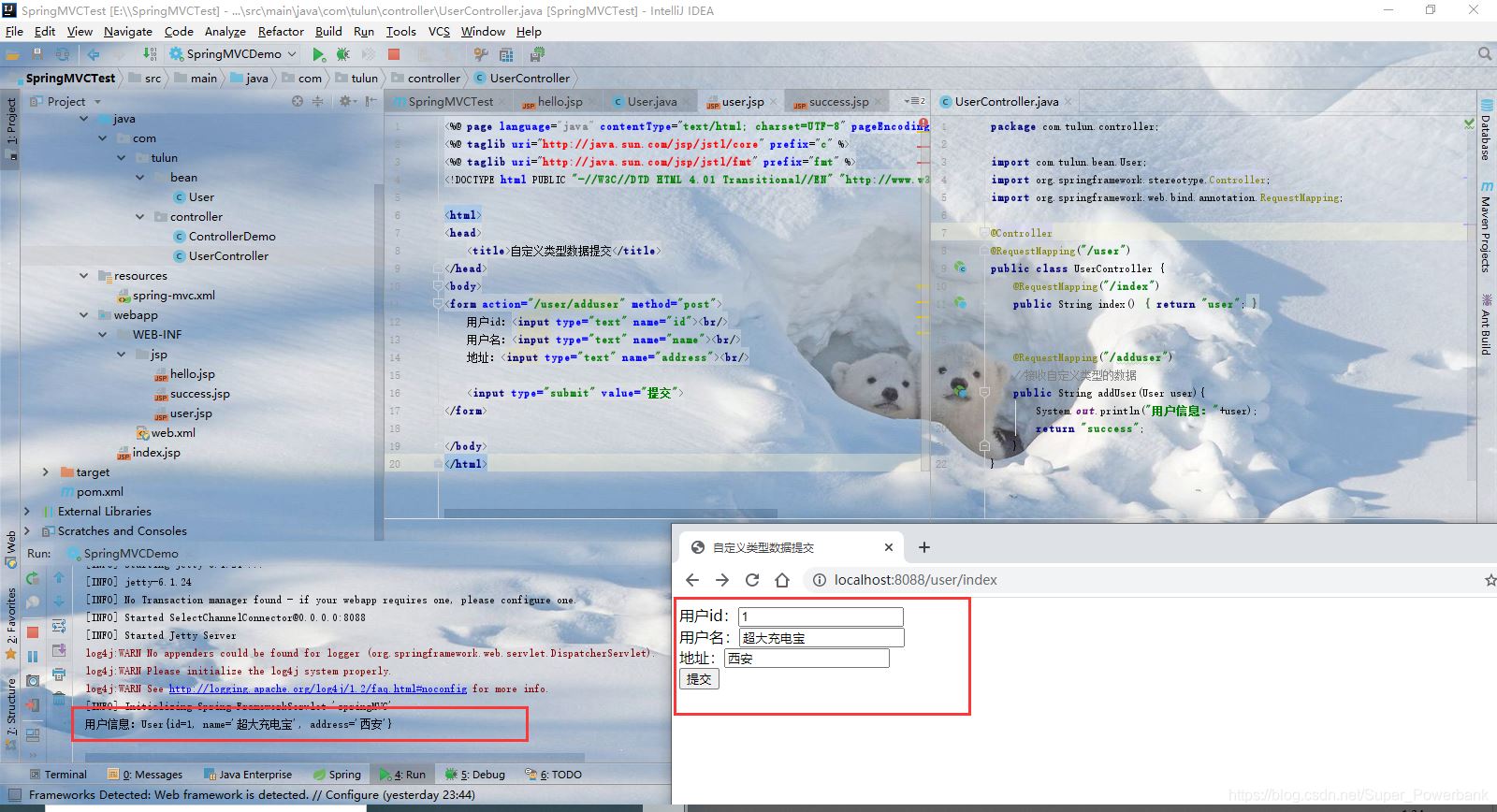
注意:頁面輸入框的name屬性值和自定義的pojo實例的屬性名保持一致即可映射成功如果類型存在 不一致時需要自定義一個類型轉化器,需要給定一個自定義的類,實現Converter接口,該接口需要執行轉化的類型,例如將前端的String的數據轉化為日期類型,即Converter<String,Date>
4、集合類型
集合類型:數組,List、Map等常用的集合類型都會支持以List集合為例進行介紹
JSP頁面
<%@ page language='java' contentType='text/html; charset=UTF-8' pageEncoding='UTF-8'%><%@ taglib uri='http://java.sun.com/jsp/jstl/core' prefix='c' %><%@ taglib uri='http://java.sun.com/jsp/jstl/fmt' prefix='fmt'%><!DOCTYPE html PUBLIC '-//W3C//DTD HTML 4.01 Transitional//EN' 'http://www.w3.org/TR/html4/loose.dtd'><html><head> <title>用戶列表</title></head><body><table border='1'> <thead> <tr> <td>用戶id</td> <td>用戶名</td> <td>地址</td> </tr> </thead> <tbody> <c:forEach items='${users}' var='user'> <tr> <td>${user.id}</td> <td>${user.name}</td> <td>${user.address}</td> </tr> </c:forEach> </tbody></table></body></html>
controller層
@RequestMapping('/userlist')//集合類型數據的傳遞public ModelAndView userList() { ModelAndView modelAndView = new ModelAndView(); //指定邏輯視圖名 modelAndView.setViewName('userlist'); //偽數據集合 ArrayList<User> users = new ArrayList <>(); User user1 = new User(); user1.setId(1L); user1.setName('張三'); user1.setAddress('陜西西安'); users.add(user1); User user2 = new User(); user2.setId(2L); user2.setName('李四'); user2.setAddress('陜西西安'); users.add(user2); User user3 = new User(); user3.setId(3L); user3.setName('王五'); user3.setAddress('陜西西安'); users.add(user3); //填充數據 modelAndView.addObject('users', users); return modelAndView;}
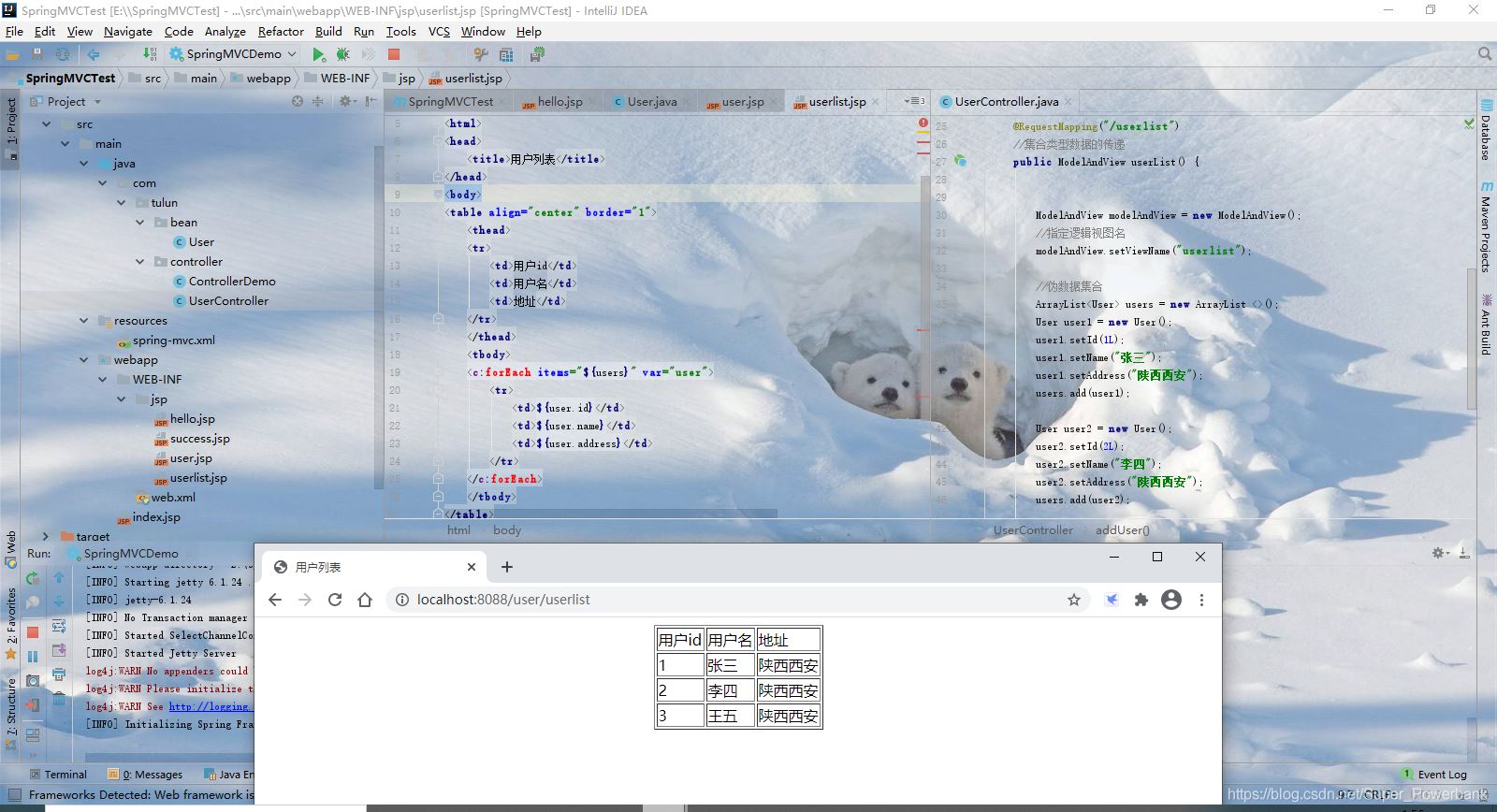
1、返回ModelAndView類型
返回結構定位ModelAndView時,將model和View分別進行設置
@RequestMapping('/userlist') //集合類型數據的傳遞 public ModelAndView userList() { //偽數據集合 ArrayList <User> users = new ArrayList <>(); ModelAndView modelAndView = new ModelAndView(); //指定邏輯視圖名 modelAndView.setViewName('userlist'); //返回數據 modelAndView.addObject('users', users); modelAndView.addObject('class', '超大充電寶'); return modelAndView; }
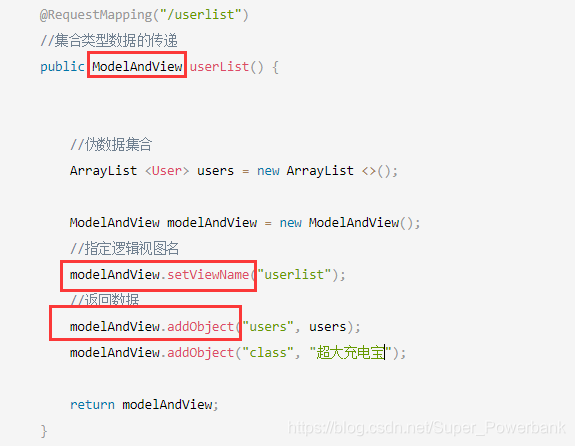
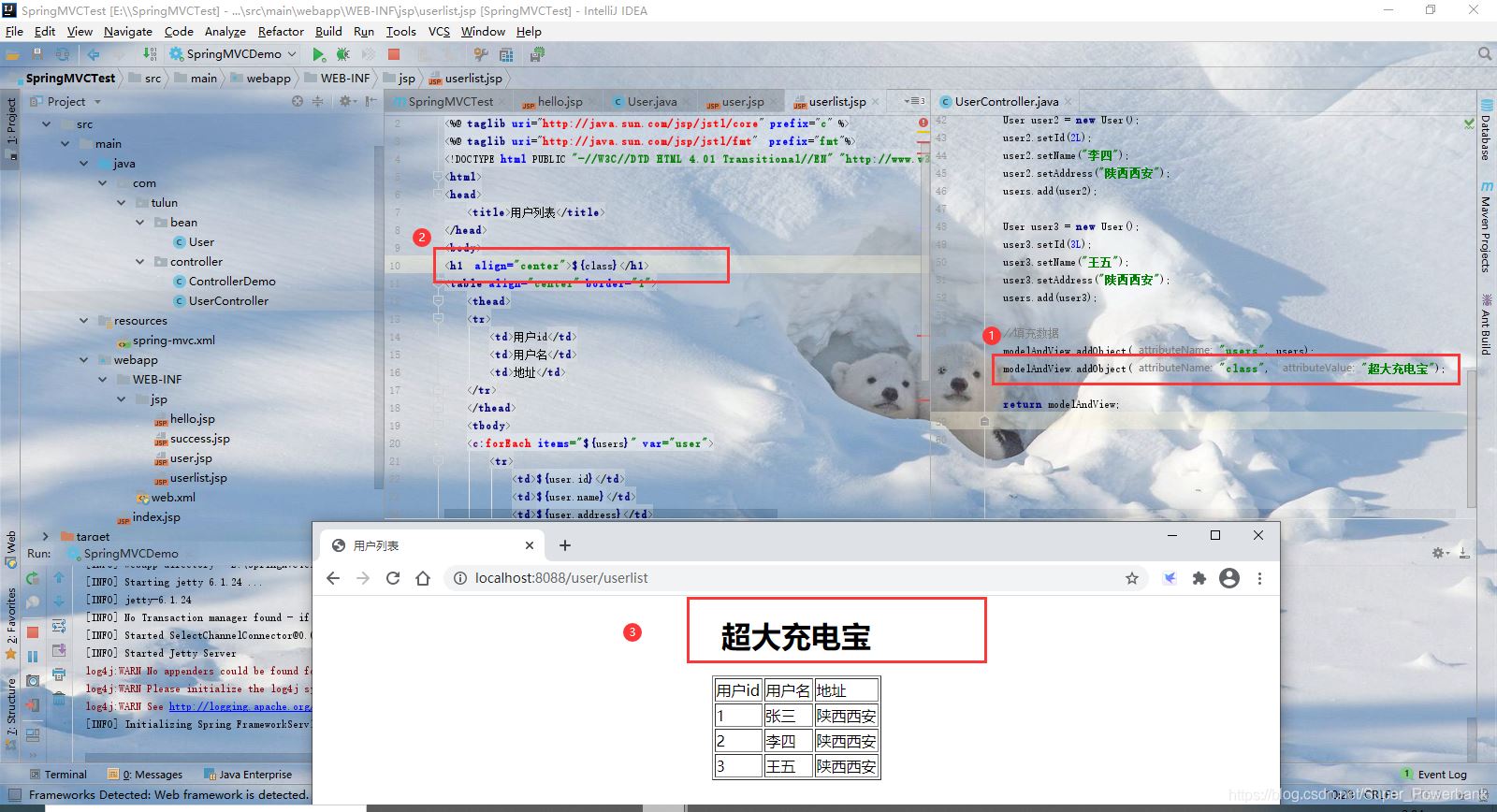
2、返回String類型 (1)返回邏輯視圖名
返回String,可以表示是邏輯視圖名
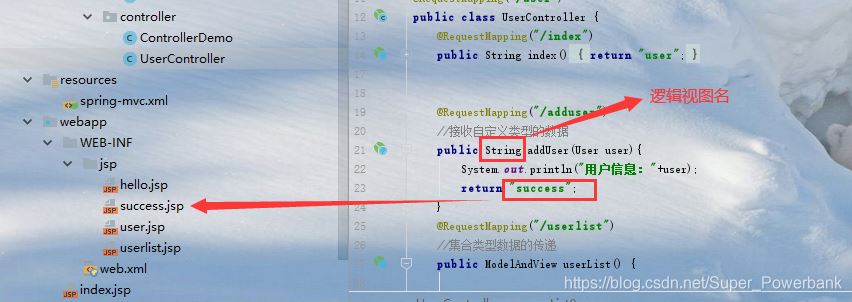
真正視圖(jsp路徑)=“前綴”+邏輯視圖名+“后綴”前綴和后綴可以在spring-mvc中設置視圖解析器組件時指定

(2)redirect重定向
redirect特點:
瀏覽器上地址URL會發生改變, 修改后的request的數據無法傳遞到重定向的頁面,即重定向時request數據無法共享
點擊提交之后,頁面跳轉到redirect指定的頁面,URL會發生改變

(3)forward頁面轉發
forward特點:
瀏覽器的地址URL不變的 request是可以共享的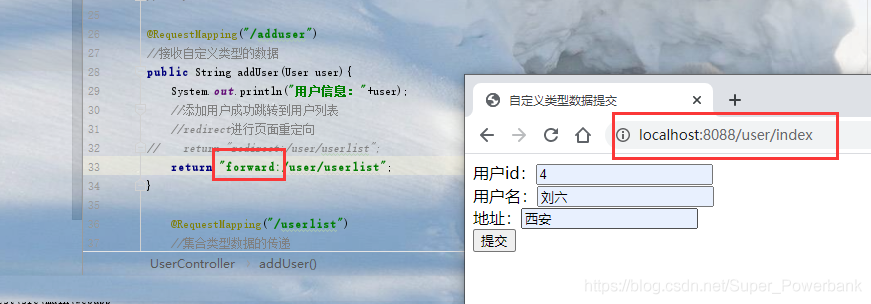
點擊提交之后,頁面跳轉到forward指定的頁面,URL不會發生改變

問題:forward和redirect的區別?
Forward和Redirect代表了兩種請求轉發方式:直接轉發和間接轉發。
直接轉發方式(Forward),客戶端和瀏覽器只發出一次請求,Servlet、HTML、JSP或其它信息資源,由第二個信息資源響應該請求,在請求對象request中,保存的對象對于每個信息資源是共享的。 間接轉發方式(Redirect)實際是兩次HTTP請求,服務器端在響應第一次請求的時候,讓瀏覽器再向另外一個URL發出請求,從而達到轉發的目的。舉個通俗的例子:
直接轉發就相當于:“A找B借錢,B說沒有,B去找C借,借到借不到都會把消息傳遞給A” 間接轉發就相當于:“A找B借錢,B說沒有,讓A去找C借”二者區別:redirect 重定向:
1、重定向會改變瀏覽器地址欄地址 。
2、重定向不止可以訪問服務器內的資源,還可以訪問外部連接 。
3、重定向因為是兩次請求,所以重定向不能使用request來訪問資源和共享數據,因為request的作用域是一次請求內。
forward 請求轉發:
1、不會改變瀏覽器地址欄信息 。
2、只能訪問服務器內部資源 。
3、是一次請求.所以可以使用request共享數據。
2、返回void類型
@RequestMapping('/void') //接收自定義類型的數據 public void result(HttpServletRequest request, HttpServletResponse response) throws ServletException, IOException { //添加用戶成功跳轉到用戶列表 request.getRequestDispatcher('/user/userlist').forward(request,response); response.sendRedirect('/user/userlist'); response.getWriter().write('hello...'); }
(1)使用request頁面轉向
request.getRequestDispatcher('/user/userlist').forward(request,response);
(2)通過response頁面重定向
response.sendRedirect('/user/userlist');
(3)通過response指定響應結果
response.getWriter().write('hello...');
到此這篇關于Spring MVC的參數綁定和返回值的文章就介紹到這了,更多相關Spring MVC參數綁定和返回值內容請搜索好吧啦網以前的文章或繼續瀏覽下面的相關文章希望大家以后多多支持好吧啦網!
相關文章:

 網公網安備
網公網安備